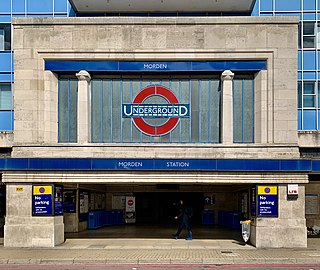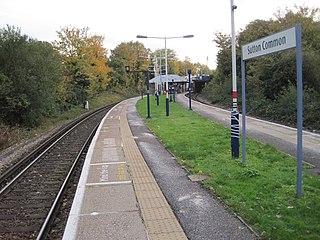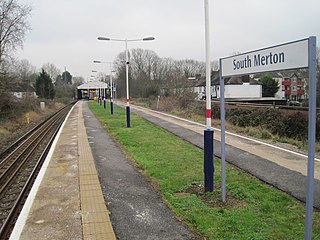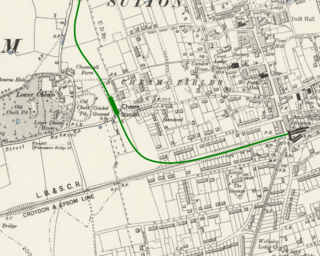
The Northern line is a London Underground line that runs between North London and South London. It is printed in black on the Tube map. It carries more passengers per year than any other Underground line – around 340 million in 2019 – making it the busiest tube line in London. The Northern line is unique on the Underground network in having two different routes through central London, two southern branches and two northern branches. Despite its name, it does not serve the northernmost stations on the Underground, though it does serve the southernmost station at Morden, the terminus of one of the two southern branches.

Morden is a London Underground station in Morden in the London Borough of Merton. The station is the southern terminus for the Northern line and is the most southerly station on the Underground network, despite being on the Northern Line. The next station towards north is South Wimbledon. The station is located on London Road (A24), and is in Travelcard Zone 4. Nearby are Morden Hall Park and Morden Park.

Wimbledon is an interchange station in the centre of Wimbledon in London for London Underground, London Trams and National Rail services, and is the only station in London that provides an interchange between the London Underground and Tramlink.

South Wimbledon is a London Underground station in South Wimbledon, a suburb of Wimbledon in south-west London. The station is on the Northern line, situated between Colliers Wood and Morden stations. It is located on the corner of Merton High Street (A238) and Morden Road (A219). South Wimbledon is on the boundary between Travelcard Zone 3 and Zone 4.

The City and South London Railway (C&SLR) was the first successful deep-level underground "tube" railway in the world, and the first major railway to use electric traction. The railway was originally intended for cable-hauled trains, but owing to the bankruptcy of the cable contractor during construction, a system of electric traction using electric locomotives—an experimental technology at the time—was chosen instead.

Tooting Broadway is a London Underground station in Tooting in the London Borough of Wandsworth, South London. The station is on the Northern line, between Tooting Bec and Colliers Wood stations and is in Travelcard Zone 3.

Sutton railway station (sometimes referred to as Sutton (Surrey) on tickets and timetables) is in the London Borough of Sutton in South London and is the main station serving the town of Sutton. It is served by Southern and Thameslink trains, and lies in Travelcard Zone 5, 14 miles 75 chains (14.94 miles, 24.04 km) down the line from London Bridge, measured via Forest Hill.

West Sutton railway station is in the London Borough of Sutton in South London, England. The station is served by Thameslink trains on the Sutton Loop Line. It is in Travelcard Zone 5. It is close to Gander Green Lane, the home ground of Sutton United.

Sutton Common railway station is in Sutton Common in the London Borough of Sutton in South London. The station is served by Thameslink and Southern trains on the Sutton Loop Line. It is in Travelcard Zone 4. It has a single stepped entrance accessible from Sutton Common Road. It is the nearest rail station to the adjoining neighbourhood, Benhilton, via the footbridge at Angel Hill.

St Helier railway station is in the London Borough of Merton in South London. The station is served by Thameslink, and is on the Sutton Loop Line. It is in Travelcard Zone 4.

Morden South railway station is in Morden in the London Borough of Merton. The station is served by Thameslink trains on the Sutton Loop Line. It is in Travelcard Zone 4.

South Merton railway station is located in Morden, the administrative centre of the London Borough of Merton in South London. The station is served by Thameslink trains on the Sutton Loop Line. It is in Travelcard Zone 4.

Wimbledon Chase railway station is in the London Borough of Merton in South London. The station is served by Thameslink trains on the Sutton Loop Line. It is in Travelcard Zone 3 and is arranged as an island eight-car platform, with stairs descending to street level towards the southern end.

The Charing Cross, Euston and Hampstead Railway (CCE&HR), also known as the Hampstead Tube, was a railway company established in 1891 that constructed a deep-level underground "tube" railway in London. Construction of the CCE&HR was delayed for more than a decade while funding was sought. In 1900 it became a subsidiary of the Underground Electric Railways Company of London (UERL), controlled by American financier Charles Yerkes. The UERL quickly raised the funds, mainly from foreign investors. Various routes were planned, but a number of these were rejected by Parliament. Plans for tunnels under Hampstead Heath were authorised, despite opposition by many local residents who believed they would damage the ecology of the Heath.
The Wimbledon and Sutton Railway (W&SR) was a railway company established by an Act of Parliament in 1910 to build a railway line in Surrey from Wimbledon to Sutton via Merton and Morden in the United Kingdom. The railway was promoted by local landowners hoping to increase their land's value through its housing development. It was initially planned that services on the railway would be operated by the London Underground's District Railway (DR) as an extension of its existing service from Wimbledon.

Elm Grove or Tennis Ground was an authorised railway station planned by the Wimbledon and Sutton Railway (W&SR) and Underground Electric Railways Company of London (UERL) but never built. It was to be located near Elm Grove in Wimbledon, in south-west London.

Elm Farm was an authorised railway station planned by the Wimbledon and Sutton Railway (W&SR) and Underground Electric Railways Company of London (UERL) but never built. It was to be located on the western edge of what is now St Helier on the border between the London Boroughs of Merton and Sutton, in south-west London.

Collingwood Road was an authorised railway station planned by the Wimbledon and Sutton Railway (W&SR) and Underground Electric Railways Company of London (UERL) but never built. It was to be located on Collingwood Road in Sutton in south-west London.

Cheam was an authorised railway station planned by the Wimbledon and Sutton Railway (W&SR) and Underground Electric Railways Company of London (UERL) but never built. It was to be located on Cheam Road in Sutton in south-west London.

Cannon Hill was an authorised railway station planned by the Wimbledon and Sutton Railway (W&SR) and Underground Electric Railways Company of London (UERL) but never built. It was to be located on Cannon Hill Lane in Merton, in south-west London.






















